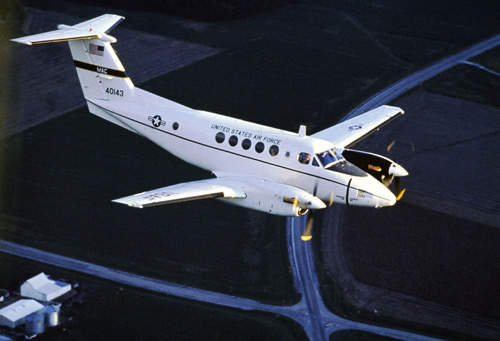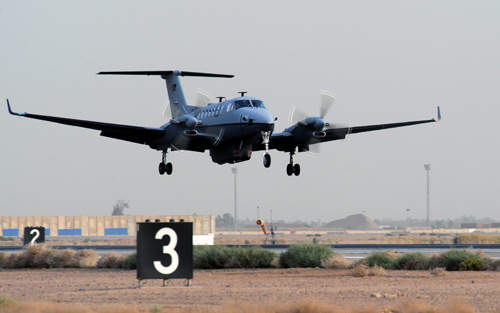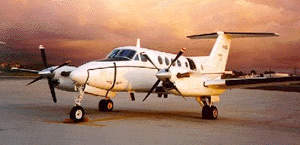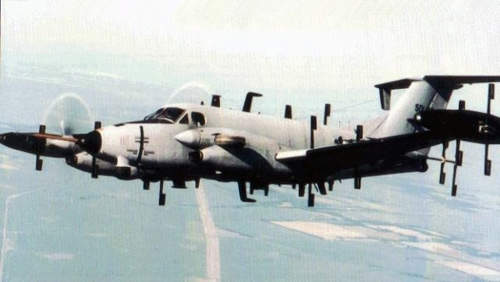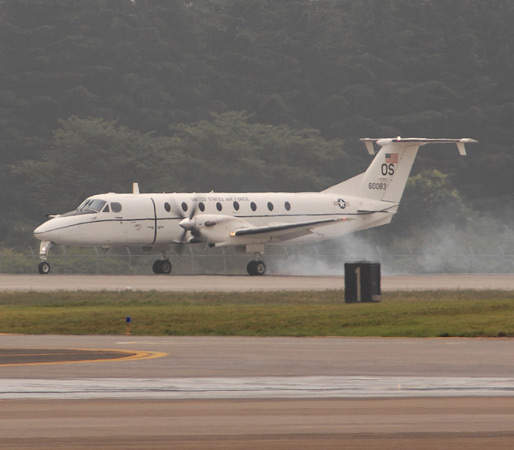The C-12 Huron is a military version of an executive passenger and transport aircraft based on the Beech Model 200 Super King Air. It is primarily used by the US Air Force, US Navy, US Army and US Marine Corps for several functions, including range clearance, embassy support, medical evacuation, VIP transport, passenger and light cargo transport. The C-12 took its maiden flight on 27 October 1972 and entered service with the US Army in 1974.Powered by a twin-engine turboprop, the C-12 aircraft is manufactured by Beechcraft in the US. The aircraft can accommodate a maximum of two crew, namely a pilot and co-pilot, and 13 passengers or 5,000lb of cargo. More than 300 aircraft are currently in service with the US armed forces. The C-12 Huron is the mainstay of operation support airlift (OSA).
System Field Support (SFS), a subsidiary of L-3 Communications, was contracted for $440m in 2010 to render Life-Cycle Contractor Support for the fleet of C-12, RC-12 and UC-35 aircraft, deployed in the US Army, Army Reserves and Army National Guard, for five years.
The US Navy and the US Air Force awarded a five-year, $300m contract to SFS in May 2011 to provide contractor logistics support (CLS) services to its fleet of C-12 aircraft.L-3 Communications won a $302m contract to provide aircraft maintenance, logistics support, and materials for the US Navy’s C-12 utility lift aircraft in 2016. The five-year contract covers trainer and reserve aircraft.
A US Navy C-12 Huron participated in a readiness exercise with other military aircraft including Koku-Jieitai F-35A Lightning II and F-16CM Fighting Falcons at the Misawa Air Base in Japan which culminated in a joint and bilateral “elephant walk” formation, in June 2020.
C-12 Huron variants
The C-12 aircraft comes with 13 variants – C-12A, UC-12B, TC-12B, C-12C, C-12D, C-12E, C-12F, UC-12F, RC-12F, C-12L, UC-12M, C-12R and C-12R/AP.
The C-12A is based on the initial model of King Air A200, which entered into service in July 1975. Two P&WC PT6A-38 turboprop engines power the C-12A.
The C-12C and C-12E variants were obtained by replacing the PT6A-38 engine of C-12A with PT6A-41 turboprop engine. The variants are similar to C-12A in terms of applications and specifications.
The UC-12B is the naval version of the King Air A200C. The variant differs from the standard C-12 in fuselage section that is divided into two compartments, the flight compartment and the cabin compartment. The variant can accommodate either one crew and seven passengers or eight passengers. The cabin seating can be removed when operating as light cargo flight. The variant is powered by a PT6A-41 turboprop engine.
The TC-12B is an advanced trainer aircraft principally used for intermediate E2/C2 training at the Naval Air Station, Corpus Christi, Texas, US. The de-icing and anti-icing systems installed in the aircraft allow flight operations under instrument and icing conditions. Around 14 UC-12B aircraft were converted to TC-12B.
The C-12D aircraft is similar to C-12C and is derived from King Air A200CT. The variant is equipped with a cargo door, high flotation landing gear and purvey for tip tanks. Approximately 21 C-12D were converted to guardrail common sensor aircraft, the RC-12.
The C-12F can carry two crew and eight passengers. The variant is derived from King Air Model B200C and can lift 1,050kg of cargo.
The UC-12F, the naval version of C-12F, is currently in service with the US Navy. Variations of the UC-12F include the addition of a surface-search radar and an operator’s console to RC-12F range surveillance aircraft (RANSAC) for the Pacific Missile Range Facility at Barking Sands, Hawaii.
The C-12L is an advanced version of the RU-21J, minus guardrail equipment, and is frequently used for transportation. The RU-21J was renamed as C-12L in the 1980s.
The UC-12M is another naval version, which has been achieved by modifying the cockpit instruments, lighting and voice communications of the C-12F aircraft.
The C-12R/AP is fitted with surface search radar to detect and track marine targets. It also captures videos of suspect drug traffickers for further use in criminal proceedings.
The US Marine Corps (USMC) ordered six UC-12W aircraft in July 2008. It awarded a contract to Hawker Beechcraft to upgrade two UC-12W Hurons with extended range fuel tanks to enhance their endurance to more than 12 hours in the air and 45 minutes of reserve fuel.
C-12 passenger and transport aircraft orders and deliveries
A total of 380 C-12s were ordered by the US Armed Forces by the 1990s.
Around 91 C-12A aircraft were procured by the US Army (60), US Air Force (30), and Greek Air Force (one). A total of 14 C-12A aircraft from the US Army were converted to C-12C. The US Navy ordered 49 UC-12B aircraft, while 17 were acquired by the US Marines for communication flights.
The US Army and Air Force procured 24 and six C-12D aircraft respectively for embassy support flights. 40 C-12F aircraft were delivered to the US Air Force in 1984 after a five-year lease, six were delivered to the Air National Guard and 17 to the US Army.
The US Navy procured 12 UC-12M in 1987, of which two were converted to the RC-12M by incorporating surface search radar and operator’s console. The US Air Force currently operates four C-12J aircraft.
C-12 Huron features
The C-12 Huron features a cargo door with a built-in airstair to provide easy access for entry and exit for both passengers and cargo. The modified flight deck and cabin is used for high-altitude flights. The aircraft’s cabin can be readily assembled to cater to passengers, cargo or both.
The autopilot, colour weather radar, tactical air navigation system, VHF and UHF radios installed in the C-12J aircraft enhance its safety and operational capabilities. The aircraft comprises a two-seat cockpit.
The multi-functional displays (MFDs) are replaced with current navigation equipment as part of a modernisation programme. The MFDs also show the required navigation information to the pilot. Other modifications in the C-12J encompass three integrated global positioning systems (GPS), two flight management systems (FMS), a new autopilot, VHF/UHF communication radios and weather radar.
C-12 Huron aircraft refuelling
The four fuel tanks in the aircraft can be refuelled through filler caps located on the top of each wing. The total fuel capacity of the aircraft is 675.2gal (2,555.2l). It can be refuelled in the air by using refuelling aircraft.
Rockwell Collins avionics
The C-12 Huron is equipped with Rockwell Collins avionics, including Collins WXR-850 weather radar, traffic collision alert and avoidance systems (TCAAS) and an integrated avionics processor system (IAPS).
The IAPS encompasses a dual FMS-3000 flight management system, a pair of GPS-4000A and an ADC-3000 air data computer. The aircraft is also integrated with a fifth MFD-255C for detecting weather conditions, flight plan and enhanced proximity warning system (EGPWS) to overlay information.
C-12 aircraft engine
The C-12 is powered by two Pratt & Whitney Canada PT6A-42 turboprop engines, which can produce a continuous power of 635kW each.
The engines feature advanced aerodynamic and material technologies that allow them to gain more power without increasing size. The technologies also reduce emissions, thereby enhancing maintenance.
The engine is also equipped with a full authority digital electronic control (FADEC) feature, which reduces the workload of pilot and decrease fuel consumption.
The length and diameter of the engine is 66.9m and 19m respectively. It can produce a revolution per minute (rpm) of 2,000.
C-12 Huron performance
The C-12 Huron can climb at the rate of 12.5m/s. The maximum speed of the aircraft is 499km/h. Its range and service ceiling is 3,338km and 10,700m respectively. The wing loading of the C-12 is 201.6kg/m², while the maximum endurance of the aircraft is five to six hours. The C-12 weighs around 3,520kg and its maximum take-off weight is 7,755kg.

